Hi all,
A new COVID surge has started. Let’s hope that this wave is only a “wavelet”. Wastewater SARS-CoV-2 levels are rising across the United States, but fortunately they are starting at a low level. Hospitalizations have increased about 11%, but COVID deaths remain low. Using mathematical modeling, J. Weiland calculates that wastewater virus levels are almost double what they were in June and 1 in 90 people is currently infected with COVID. We are seeing a mix of variants causing this wavelet- EG5.1, FL1.5 and XBB1.16.6, all of which have the F456L mutation. Immunity is waning because it has been a long time since the last COVID wave and since many people have not had recent vaccine boosters. Here in Palo Alto and in San Francisco, wastewater viral levels are also increasing.
An algorithm called COVID-SURGE was able to use wastewater viral levels to predict the last two surges before they happened. Another article shows that the Omicron variant quickly spread across the globe via airline travel. Researchers suggest testing the wastewater from airlines and airports to be able to prepare for variants that are arriving.
As a reminder, if you do test positive for COVID, you can get Paxlovid to help reduce the severity of the infection and reduce the risk of Long COVID. The California Department of Public Health states that: “Medications to treat COVID-19 are free, widely available, and effective for stopping COVID-19 illness from getting serious. Everyone 12 years and older who has symptoms and tests positive for COVID-19 should ask a doctor about treatment.” In California, call 833-422-4255 in California to get Paxlovid. Across the United States, there are many “Test-to-Treat" programs at pharmacies that will test a person and will immediately give them Paxlovid if they are positive. SARS-CoV-2 variants that are resistant to Paxlovid are rare (only 0.16%) which is great news.
Vaccines
Project NextGen will give $5 billion from the federal government to make variant-proof COVID vaccines, mucosal (nasal vaccines) to block the virus from entering the body and monoclonal antibodies to treat beta-coronaviruses including SARS-CoV-2. A new study shows that writing a one time personal message increased vaccine booster rates by 33%, but that giving money incentives did not. Vaccine uptake in Ohio and Florida were found to differ depending on a person’s political affiliation and those who did not get vaccinated had higher death rates. The Fall booster in the U.S. will be a monovalent XBB variant vaccine. In China, they plan a trivalent Fall booster containing XBB.1.5, Delta and BA.5 subvariants.
COVID and the Brain
A new, important study in hamsters shows that all SARS-CoV-2 variants can invade the brain via the olfactory nerves in the nose whether or not there is ansomia (loss of smell). As Dr. Tatiana Prowell tweeted, “We cannot assume the brain has been spared just because there was no loss of smell or other symptoms. We should do our best to avoid COVID-19 infections.”
Dr. Wes Ely’s critical care group at Vanderbilt wrote a comprehensive article on Neuro Long COVID and how to decrease the neurological, cognitive, and psychiatric sequelae of COVID-19-related critical illness. The summary diagram of the possible mechanisms and treatments for persistent neuropsychological impairments in Long COVID is very helpful. A prospective study from the UK that followed people for two years after an acute COVID infection, showed persistent cognitive deficits seen on cognitive testing, especially noted in people with longer symptom durations, ongoing symptoms, and/or more severe infection with their initial COVID infection.
If you read one article this week, I recommend reading Ed Yong’s essay on Long COVID and “fatigue” in the Atlantic. Yong interviewed people with Long COVID and ME/CFS who told their stories of a crippling disease that zaps people’s ability to do normal things like making a meal or taking a shower. He discusses post-exertional malaise (PEM) and how it is metabolically toxic and different from normal fatigue. I personally have a family member with severe Long COVID, POTS and ME/CFS, and what Ed Yong reports is our reality.
An editorial from the Lancet asks “Where are the Long COVID trials?” Although ClinicalTrials.gov lists 386 trials for Long COVID, only 12 trials are testing pharmacological interventions. The STOP-PASC clinical trial at Stanford University which was testing nirmatrelvir-ritonavir (Paxlovid) in patients with long COVID is closing their enrollment early. To understand what people with ME/CFS and Long COVID go through, I’d recommend watching the film UNREST by Jennifer Brea.
According to the most recent CDC Pulse survey, 6.8% of U.S. adults currently have Long COVID and 25% of them have significant limitations on their daily activities. The Urban Institute reports that for people with Long COVID, 42% report food insecurity, 23% can’t pay their utility bills and 20% have trouble paying their rent or mortgage. Long COVID makes it hard or impossible to work, which leads to difficulties paying bills.
A new review in Pediatrics shows that 16.2% of children and adolescents have at least one Long COVID symptom. Kids are not spared from long term effects of COVID infection as was initially thought. In addition, as COVID cases increased, Type 1 diabetes in children and teens increased 10-fold.
In non-COVID news, the Harvard Alcohol Project researchers normalized the idea of a “designated driver” in 1988 by asking writers to include the idea of designated drivers into tv and movie scripts. Hepatitis C (HCV) is increasing in pregnant people so universal HCV screening with each pregnancy is recommended. As climate change increases temperatures, a group in Germany is growing hops for beer under solar panels. It’s a win-win as the hops prefer the cooler temps under the solar panels and the electricity made can power 250 households.
Low-dose aspirin is not recommended for healthy older adults because it did not reduce ischemic stroke risk and actually increased potentially deadly risks of bleeding in the brain. Virtual reality (VR) was found to reduce anxiety in brain tumor patients during treatment. In an ode to Dr. Doolittle, a group is using machine learning to try to understand what animals are actually saying. Perhaps this could help us understand why these three whales all jumped out of the water in unison- was it to teach a calf how to breach? Or was it just for a little fun?
Have a good rest of your weekend,
Ruth Ann Crystal MD
COVID news:
US Variant tracker: https://covid.cdc.gov/covid-data-tracker/#variant-proportions
CDC COVID data tracker: https://covid.cdc.gov/covid-data-tracker/index.html#datatracker-home
CDC COVID Hospitalizations (blue) and Emergency Room (orange) visits tracker: https://covid.cdc.gov/covid-data-tracker/index.html#trends_weeklyhospitaladmissions_7dayeddiagnosed_00
US Wastewater Monitoring:
CDC Wastewater Monitor https://covid.cdc.gov/covid-data-tracker/#wastewater-surveillance
Increases seen in Nebraska, parts of NY state, North Carolina, Florida, Delaware, New Jersey, etc.
Wastewater from NWSS and Biobot in a US map format:
https://iowacovid19tracker.org/
Biobot: https://biobot.io/data/
“This increase is driven by the new swarm with F456L: EG.5.1, FL.1.5.1, XBB.1.16.6. There is also considerable immune waning from such a long time between waves.”
Sewer Coronavirus Alert Network (SCAN) project by Stanford University:
https://longcovid.physio/long-covid-video-series
California Dept of Public Health: https://covid19.ca.gov/treatment/
“Medications to treat COVID-19 are free, widely available, and effective for stopping COVID-19 illness from getting serious.
“Everyone 12 years and older who has symptoms and tests positive for COVID-19 should ask a doctor about treatment.”
US Test-to-Treat Locator:
https://covid-19-test-to-treat-locator-dhhs.hub.arcgis.com/
To find a location that will give you a COVID test and then give you a prescription for medication such as Paxlovid.
MUST READ: 7/27/23 Ed Yong on Long COVID in The Atlantic: Fatigue Can Shatter a Person https://buff.ly/3O7UjhD
Version without the paywall: Fatigue Is So Much More Than Being Tired - The Atlantic https://buff.ly/3DvJn8y
“Alexis Misko’s health has improved enough that, once a month, she can leave her house for a few hours.”
“Post-exertional malaise, or PEM, is the defining trait of ME/CFS and a common feature of long COVID…“You feel poisoned, flu-ish, concussed,” Misko said. And where fatigue usually sets in right after exertion, PEM might strike hours or days later, and with disproportionate ferocity. Even gentle physical or mental effort might lay people out for days, weeks, months.
People with “PEM might appear well to friends and colleagues who then don’t witness the exorbitant price they later pay.
“PEM inverts the dogma that exercise is good for you—an adage that, for most other illnesses, is correct.
Visible App: Activity tracker for Long COVID and ME/CFS
8/2023 Lancet: Where are the Long COVID trials? https://buff.ly/3YdqH73
ClinicalTrials.gov currently lists 386 trials under the search term Long COVID. However, only 94 of those studies are classed as interventional and are currently recruiting, and even more disturbing, only 12 trials are testing pharmacological interventions.
The STOP-PASC, a clinical trial at Stanford University, CA, USA, testing nirmatrelvir-ritonavir (Paxlovid) in patients with long COVID, is closing enrolment before the full study size has been reached.
There is a desperate need for long COVID treatments.
Watch the film UNREST about ME/CFS here:
Jennifer Brea is working on her PhD at Harvard and about to marry the love of her life when she’s struck down by a mysterious fever that leaves her bedridden. When doctors tell her “it’s all in her head,” she turns her camera on herself to document her devastating symptoms. Searching for answers, Jennifer discovers a hidden world of millions confined to their homes and bedrooms by ME, commonly known as chronic fatigue syndrome. Together, Jen and her new husband, Omar, must find a way to build a life and fight for a cure.
7/26/23 Nature (Institut Pasteur): Neuroinvasion and anosmia are independent phenomena upon infection with SARS-CoV-2 and its variants https://buff.ly/3rKA5mG
Hamsters
All SARS-CoV-2 variants tested (Wuhan, Wuhan ORF7-deletion mutant, Gamma, Delta and Omicron/BA.1) can invade the brain via the olfactory nerves whether or not there is anosmia (loss of smell).
The SARS-CoV-2 virus travels inside the axons of neurons in both retrograde and anterograde directions..
The ORF7 of SARS-CoV-2 contributes to the induction of olfactory dysfunction.
All SARS-CoV-2 variants are neuroinvasive, regardless of the clinical presentation (with or without loss of smell a.k.a. anosmia).
7/26/23 NEJM (X.Becerra, Ashish Jha): Project NextGen — Defeating SARS-CoV-2 and Preparing for the Next Pandemic https://buff.ly/47a1yhS
Immunity against SARS-CoV-2 from both vaccines and infection wanes over time.
Next-generation vaccines and treatments that are variant-proof are needed.
Project NextGen is a $5 billion federal investment that will focus on three main areas:
vaccines that provide broader immunity both against new SARS-CoV-2 variants and across the family of epidemic-prone sarbecoviruses,
vaccines that generate effective mucosal (nasal) immunity to block infection and transmission, and
monoclonal antibodies to treat beta-coronaviruses.
CDC Post-COVID Conditions (Long COVID) | Pulse survey data https://buff.ly/3Yp3UWd
#pwLC = people with Long COVID
7/20/23 Urban Institute: Employment and Material Hardship among Adults with Long COVID in December 2022 https://buff.ly/3DuFjW7
h/t Lisa McCorkell
7/17/23 Lancet (Wes Ely MD): Mitigating neurological, cognitive, and psychiatric sequelae of COVID-19-related critical illness https://buff.ly/44EOfnR
Neuropsychiatric Long COVID after ICU
Possible mechanisms of brain/neurologic involvement in Long COVID (after ICU) and potential treatment approaches
7/17/23 Lancet (UK): Post-acute sequelae of COVID-19 (PASC, Long COVID): understanding and addressing the burden of multisystem manifestations (after critical illness) https://buff.ly/3O89cAC
The substantial burden of this multisystem condition is felt at individual, health-care system, and socioeconomic levels, on an unprecedented scale.
Review of Long COVID effects on various organ systems, potential pathophysiological mechanisms, and challenges of clinical care and support for survivors of critical illness with multisystem manifestations.
7/21/23 JAMA: Prevalence of Low-Frequency, Antiviral Resistance Variants in SARS-CoV-2 Isolates in Ontario, Canada 2020 to 2023 https://buff.ly/43NLG1j
SARS-CoV-2 variants that are resistant to Paxlovid are rare (only 0.16%).
7/25/23 PNAS: Separating signal from noise in wastewater data: An algorithm to identify community-level COVID-19 surges in real time https://buff.ly/3rG5O8p
Simple real-time algorithm of wastewater data called Covid-SURGE successfully identified the start of two very different variant-based surges and can be used to alert public health officials.
7/24/23 PNAS: Reminders, but not monetary incentives, increase COVID-19 booster uptake https://buff.ly/43M3r14
Randomized controlled trial with 57,893 patients, we found that a one-time personal reminder message increased booster vaccination rates by nearly 33% but small financial incentives of $25 had no additional impact.
7/24/23 JAMA: Excess Death Rates for Republican and Democratic Voters in Florida and Ohio During the COVID-19 Pandemic https://buff.ly/3K8iYl1
“Excess mortality was significantly higher for Republican voters than Democratic voters in Florida and Ohio after COVID-19 vaccines were available to all adults, but not before.
7/21/23 Pediatrics: A Systematic Review of Persistent Clinical Features After SARS-CoV-2 in the Pediatric Population https://buff.ly/3Or3B9N
Long COVID in kids: 16.2% of children and adolescents with a laboratory-confirmed diagnosis of COVID-19 experienced 1 or more persistent symptom(s) at least 3 months post COVID-19.
It was thought at first that the pediatric population was relatively spared from the long-term effects of COVID-19 after infection, but this changed rapidly with increasing reports and studies of pediatric patients not fully recovering from acute COVID-19.
Sore throat, persistent fever, sleep disturbance, fatigue, and muscle weakness were among those most commonly reported of more than 20 persistent or new onset symptoms after the acute infection of SARS-CoV-2 in children.
High-quality, prospective studies with proper controls are needed.
7/22/23 NBC: Ready for another 'tripledemic'? CDC prepares for a winter of '3 bugs out there' https://buff.ly/3pYR83G
3 winter viruses: COVID, Flu and RSV
“I think most of us are going to recommend it’s OK to get flu and Covid vaccines together, but wait a bit until you get the RSV” shot, Dr. Schaffner said.
RSV vaccine is for the elderly and is expected to be approved for pregnant people soon.
7/23/23 T.Ryan Gregory (evolutionary biologist) thread
Pfizer, Moderna and Novavax Fall boosters will be using monovalent XBB.1.5.
Some countries will limit the boosters to elderly and medically vulnerable (Canada, UK).
Young children remain highly affected too.
China will make a trivalent vaccine with XBB.1.5 + BA.5 + Delta to cover possible recombinants that could arise. China just had a huge number of BA.5 and now XBB infections.
7/21/23 Lancet: The effects of COVID-19 on cognitive performance in a community-based cohort: a COVID symptom study biobank prospective cohort study https://buff.ly/3Y1zwkr
Prospective study with uninfected controls.
Two years after acute COVID infection, there were persistent cognitive deficits seen on cognitive testing, especially in people with longer symptom durations, ongoing symptoms, and/or more severe infection.
7/21/23 Nature: As COVID-19 cases rose, so did Type 1 diabetes — no one knows why https://buff.ly/3q8NS5M
The COVID-19 pandemic precipitated a jump in cases of type 1 diabetes in children and teenagers.
Before COVID-19, the incidence of type 1 diabetes in children was rising at a steady rate of around 2–4% a year. With COVID the increase was 14% in 2020 and 27% in 2021. That's a 10x increase from prior years.
6/7/23 Cell: Dispersal patterns and influence of air travel during the global expansion of SARS-CoV-2 variants of concern https://buff.ly/3Y4o7Am
>80 countries had received Omicron within 100 days of its emergence, with increased passenger air travel and higher transmissibility.
Genomic surveillance along the hierarchical airline network would be prudent.
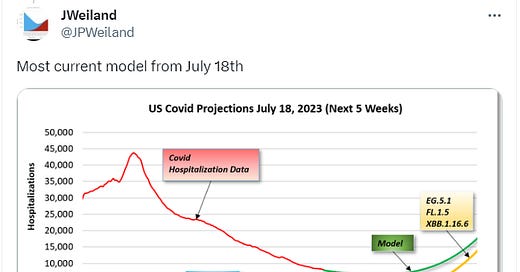




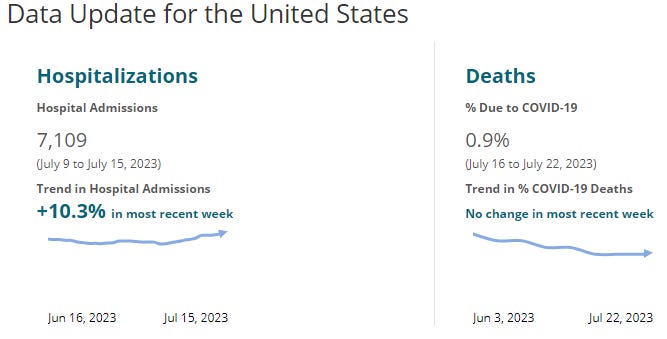



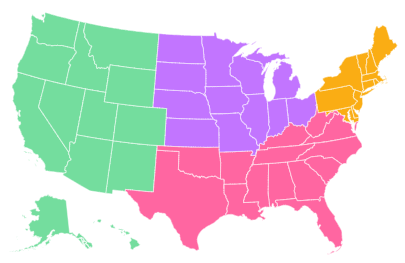



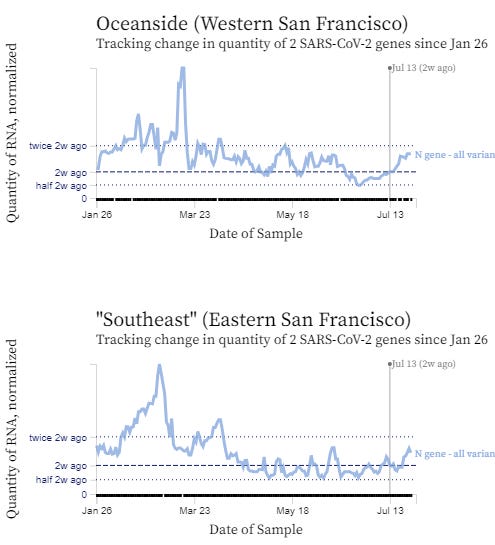



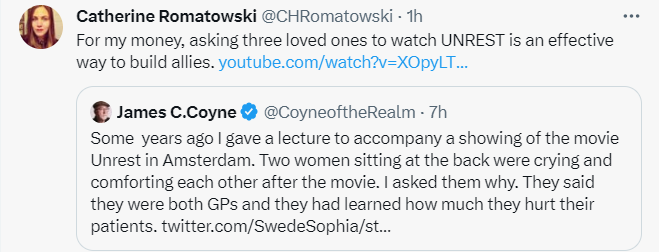
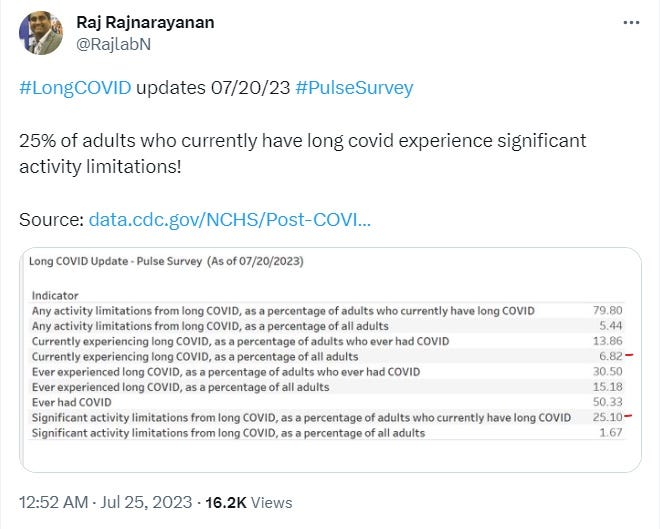






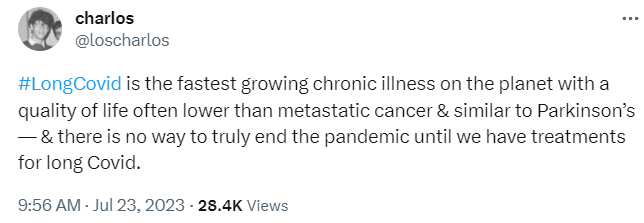


🙏🏽 🙏🏽🙏🏽
Thank you so much for your incredibly useful newsletter. I always look forward to reading it and sharing the information you provide to my family & friends. I hope your family member reaches a full recovery as soon as possible. It’s tragic to see LC politically be brushed under the rug.